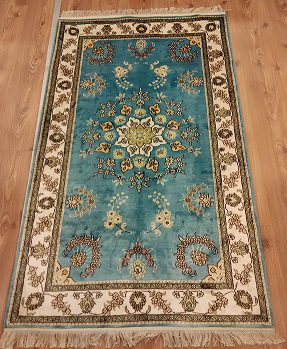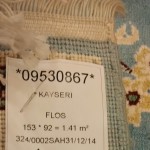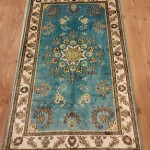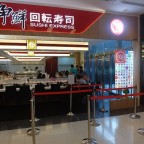You’d probably consider purchasing a Turkish carpet while travelling across Turkey. However, before you sink hundreds (and even thousands) of dollars into buying a Turkish carpet, it would be worthwhile to read this article. Afterall, a Turkish carpet could probably be your most prized investment while travelling in Turkey…
How to choose a good Turkish Carpet
To decide on how to choose a good Turkish carpet, here are some things that you should consider first.
Factors to consider before buying a Turkish carpet
1. Hand made or factory made Turkish carpet. If you’re purchasing a Turkish carpet in Turkey, it will be very likely that your carpet will be hand made. During our Turkey trip, we visited a Turkish carpet factory where were shown the process of producing a hand woven Turkish carpet. If you’re purchasing a hand made Turkish carpet (as opposed to a factory produced Turkish carpet), you’d need to know that it takes alot of time to stitch every knot on your carpet. Typically, a hand made Turkish carpet costs approximately 100x more than a factory made one.
2. Material used on your Turkish carpet. Different materials used can also affect the price of your Turkish carpet. Typical materials used include wool, cotton, mercerised cotton or silk. Wool is usually a cheaper material with silk being the most expensive.
3. Knowing your knots. You’d be pleased to know that the Turkish carpet can only be called Turkish carpet because of the Turkish double knots that are used in its production. The Turkish double knot forms a closer (and stronger) knit on the carpet and as a result produces a higher quality carpet with vibrant images. In addition, due to the material used, the number of knots per square inch (kpsi) also varies. Typically, wool is thicker than silk and thus requires less number of knots to fill a certain area. Silk on the other hand needs ALOT more knots to fill up the same area as compared to the other materials.
4. Physical appearance of Turkish carpets. Because of the knots and types of materials used, you’ll notice that light is reflected differently at different angles, producing different shades of the colour. If you take a look at the pictures above, you’ll see a lighter shade of blue when seen from one angle and a “tiffany-shade” of blue when seen from the other side. If you flip your Turkish carpet over, you’ll also be able to see the intricacy of the knots used. The more knots used, the clearer the carpet pattern is depicted on the underside. Which also means, the clearer the pattern is on the reversed side, the more expensive it is.
5. Dyes. Vegetable (natural) dyes are typically used on your Turkish carpets. As compared to chemical dyes, vegetable (or natural) dyes typically retains its colour for a longer time. Which is why the shop owners are able to guarantee that your Turkish carpet is able to last for 2 or 3 generations.
Lastly…the Turkish carpet is considered a work of art. Choose something that you really like and not be coerced into owning one. When Kate and I went for the visit to the Turkish carpet factory, we already had an idea of what carpet to buy (size and colour). We then laid our eyes on the carpet above and the price started at $3700USD (all prices are quoted in USD). After reduction, it came to $1500USD. The owner of the factory then came in and gave another $100USD discount. Kate bargained a little more and we came away with this 1.5m x 0.9m carpet made of mercerised cotton at $1300USD.
If you enjoyed our content, “Like” us on Facebook Today!
Purchasing a Turkish carpet can be one of the most satisfying purchase you will make. Do read through and consider our factors above before you consider buying that prized Turkish carpet!
What do you think of our guide on “How to purchase a Turkish carpet“? Did we overpay for our Turkish carpet? Tell us more in the comments section below!









I personally could not tell you if a carpet was old or new but I did have a third generation carpet buyer tell me some tips. Single knot is not better than dounble knot, just different places use different knot. Wool on cotton, wool on wool with natural dye will last for many generations. Make sure if they say its silk that it is silk, sometimes they’re polyester. If you get a natural dye carpet more than 50 years old expect to pay more than $4,000. If you get a Pakistani carpet you can get for around $1000. Just because you go to factory does not mean you are gettıng a Turkish or Iranian carpet you may still get a Pakıstani or Chinese carpet.
Hi Valerie,
Thanks for the comments! I guess that’s really true! Is there any way to tell if the carpet we bought is really from Turkey? That would really help our readers who wish to get a Turkish carpet in the future!
Tom,
2bearbear.com